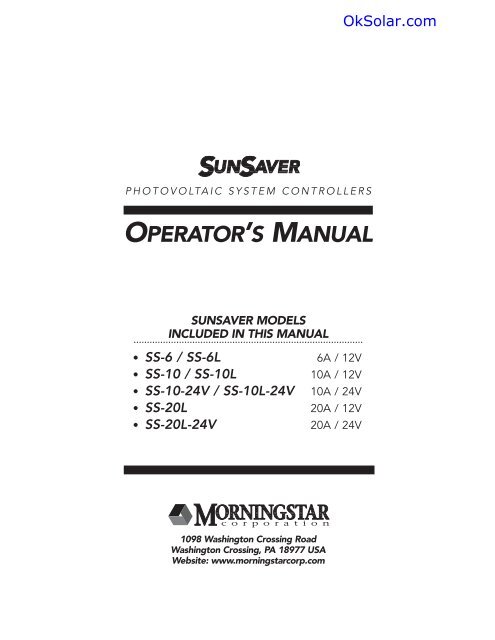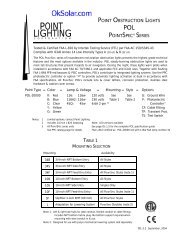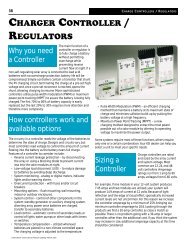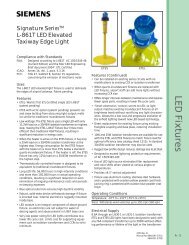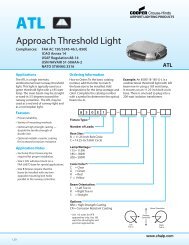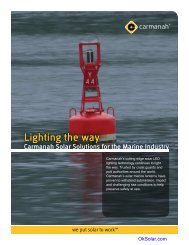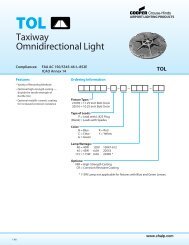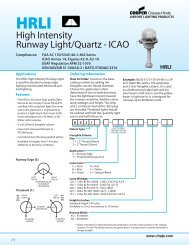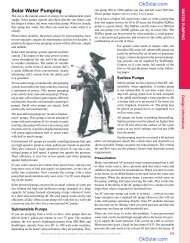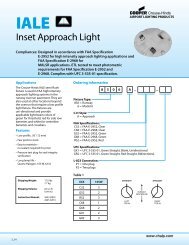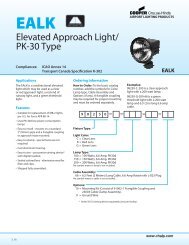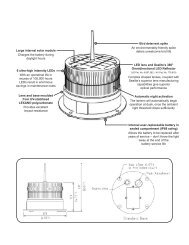OPERATOR'S MANUAL - OkSolar.com
OPERATOR'S MANUAL - OkSolar.com
OPERATOR'S MANUAL - OkSolar.com
You also want an ePaper? Increase the reach of your titles
YUMPU automatically turns print PDFs into web optimized ePapers that Google loves.
<strong>OkSolar</strong>.<strong>com</strong>5. Connect the SOLAR (PV array) next. The green LED indicatorwill light if sunlight is present.6. Connect the LOAD last. If this model includes an LVD andthe red LED indicator lights, the battery capacity is low andshould be charged before <strong>com</strong>pleting the system installation.(Refer to Section 5.3)7. The controller is shipped with a jumper installed. This setsthe controller for charging SEALED batteries.If a FLOODED battery is being used, simply remove thejumper to optimize the battery charging for a flooded battery.If the jumper is connected again, the charging will returnto the setpoints for a sealed battery. (Refer to Section 5.3)8. For most effective surge protection, it is re<strong>com</strong>mended thatthe battery negative conductor be properly grounded.4.0 LED INDICATORSGREEN LED:The green LED indicator will light whenever sunlight is availablefor battery charging. The green LED will turn off at night.Because the SunSaver uses a PWM constant voltage chargingprocess, there is usually some amount of energy going into thebattery at all times. Although the charging current falls to verylow levels when the battery reaches full charge, the green LEDwill continue to stay ON (during the daytime). This is to indicatethat the controller is working and that energy is availablefrom the PV array for charging.RED LED:If your SunSaver model includes an automatic load disconnect(LVD) feature, a red LED indicator is also provided. Wheneverthe battery charge state falls below the LVD setpoint, the loadwill be disconnected and the red LED will light. This indicatesthat the controller has disconnected the load to protect thebattery from further discharge and possible damage.After some period of recharging the battery such that it recoversto approximately 40 to 50 percent of its rated capacity, theload will automatically be reconnected and the red LED willturn off.6
<strong>OkSolar</strong>.<strong>com</strong>5.0 INSTALLATION INSTRUCTIONS5.1 RATINGS AND LIMITS• The SunSaver is rated for 12 volt (or 24 volt) PV systems. Donot connect to a PV array with open circuit voltage (Voc)greater than 25 (or 44) volts.• Maximum array short circuit current rating:SUNSAVER-6 8.1 ampsSUNSAVER-10 12.5 ampsSUNSAVER-20 25.0 amps• Because the SunSaver is a series controller, the PV currentrating is specified at the PV array’s peak power (Ipp). TheSunSaver does NOT short the PV array for regulation, andit is not necessary to derate the controller for short-circuitcurrent (Isc) as is <strong>com</strong>monly done with shunt controllers.• SunSaver models with an automatic low voltage load disconnectfunction (LVD) are rated for either 6, 10 or 20 amp loadsdepending on the model.• SunSaver models without an LVD capability are rated for amaximum load of 10 amps. All loads connected to the SunSaverLOAD terminals should not exceed 10 amps of current.NOTE: It is not necessary to use the SunSaver loadterminals. Loads that exceed the load rating of theSunSaver can be connected directly to the battery.• The rated PV input current and the rated load current canboth be exceeded by 25% for up to 5 minutes. This 25%overload will reduce the safety margins for surges and willcause heating that can shorten the life of the controller.For the reasons noted above, these higher overload ratingsshould NOT be used for routine operation. They are only tonote overload capability for system design purposes.• The SunSaver is designed to operate continuously in 60°Cambient temperatures. However, do not install the controllernear heat generating sources or in direct sun. This couldcause the temperature rating to be exceeded and damagethe controller.• The date of manufacture can be found on the serial number(bottom of case). The first 4 digits are the year and week.7
<strong>OkSolar</strong>.<strong>com</strong>5.2 POLARITY PROTECTIONThe SunSaver is generally protected from reversed connections,but the system operator and other equipment will be atrisk when polarities (+ and –) are reversed. Carefully checkbefore making each connection to be certain the polarity iscorrect.5.3 INSTALLATION PROCEDURENOTES:• The SunSaver prevents reverse current leakage at night, soa blocking diode is not required in the system.• The connector terminals will accept a maximum wire sizeof AWG #10 (up to 5.2 mm 2 ). A flathead screwdriver isrequired. (Some #10 spade connectors may not fit in thisterminal.)• Tighten each terminal clamping screw to 20 inch-pounds oftorque.• The SunSaver is designed to regulate power from a PVarray. Other generators can be connected directly to thebattery, however, with no effect on the SunSaver.• Do not connect any system wires (Solar, Battery, Load) tothe SEALED OR FLOODED SELECT terminal.• The installation should follow the requirements of the U.S.National Electric Code, Section 690.• The installation should follow the requirements of theNational Electrical Code Article 501-4(b) and/or CanadianElectrical Code Article 18-156 when installing a SunSaver ina Hazardous (Classified) Location.Refer to the connection diagram on page 5 to illustrate each ofthe following installation steps.1. Inspect the controller for shipping damage. If possible,mount the SunSaver to a vertical surface.Allow a minimum of 5 cm (2 inches) space above and belowthe controller for air flow. Protect the controller from directsunlight or other heat sources.The SunSaver can be mounted outdoors. Avoid mounting inin direct rain such that water could collect under the cover. Ifinstalled in an enclosure, some ventilation is re<strong>com</strong>mendedto minimize operating temperatures.8
<strong>OkSolar</strong>.<strong>com</strong>NOTE: The SunSaver is very corrosion resistant. The caseis hard coat anodized, cover screws are stainlesssteel, the circuit is encapsulated, and the terminalsare copper and nickel plated brass.2. Confirm that the PV array and loads will not exceed thecurrent ratings of the SunSaver model being installed(see specifications on page 2).NOTE: Multiple SunSavers can be connected in parallelto charge a single battery. Make sure each PVsub-array does not exceed the solar rating of theSunSaver, and be careful not to connect a loadthat exceeds a single SunSaver’s load rating.Separate loads can be connected to differentSunSavers.3. CONNECTION ORDER The label has each system connectionnumbered from 1 to 6. This is the re<strong>com</strong>mended orderof system connections. However, a different order will notdamage the controller.4. BATTERY Connect the 12-volt (or 24-volt) system battery.The green LED will not light. If a red LED (LOAD DISCON-NECT) is provided with this model and it lights, the batterycharge state is low and should be recharged before<strong>com</strong>pleting the installation.NOTE: If the battery voltage is below 11.5 volts (or23.0 volts), the load has been automaticallydisconnected due to a very low battery chargecondition, and the battery must be recharged.NOTE: If the battery voltage is between 11.5 and 12.0(or 23 and 24) volts, the SunSaver will sometimespower-up during initial installation in the LVD(load disconnected) state. This will automaticallyclear when the battery voltage rises above 12.6(or 25.2) volts. The LVD can also be reset manually(only if the battery voltage is above 11.5 (or 23)volts). First connect the SOLAR array (see step 5below). Next disconnect and then reconnect theBATTERY positive wire. The red LED will turn offto indicate that the LVD has been reset.9
<strong>OkSolar</strong>.<strong>com</strong>5. SOLAR First, be certain the battery (+ and –) is connectedcorrectly. Then connect the PV array to the SOLAR terminals.Be CERTAIN that the PV + and – wires are connectedcorrectly. The green LED will light if the array is connectedduring the daytime.CAUTION: Remember that the PV array will generatepower whenever in sunlight. Also, be carefulnot to SHORT-CIRCUIT the PV array whileconnected to the controller, since this willDAMAGE the controller.6. LOAD Turn the load off. Connect the load to the LOADterminals, and then turn the load on.If the load causes the red LED to turn on (for models withLVD) soon after the load was activated, the battery must berecharged. (see Section 6.2)7. SEALED OR FLOODED SELECT The SunSaver is shippedwith a jumper installed between the LOAD-negative terminal(connection 5) and the SEALED OR FLOODED SELECT terminal.With this jumper installed, the SunSaver is configuredfor charging SEALED batteries.If your PV system has a FLOODED battery, simply removethe jumper to change the SunSaver to a flooded batterycharger. (see Section 6.2)The SunSaver can be changed between SEALED andFLOODED as many times as you wish by using the jumper.Save the jumper for future use in case your battery type ischanged. If the jumper is lost, a wire can also be used.8. For safety and the most effective lightning protection, thenegative conductor of the PV system should be properlygrounded. The SunSaver connects the PV-negative, Batterynegativeand Load- negative internally per UL re<strong>com</strong>mendations.No switching is done in the negative current path.6.0 OPERATION6.1 OPERATOR TASKSThe SunSaver is a fully automatic PV system controller thatincludes electronic functions to protect both the controller and10
<strong>OkSolar</strong>.<strong>com</strong>the PV system. Battery charging is managed by a constant voltagePWM algorithm that has been optimized for PV systems.The only manual tasks performed by the operator are:a. Installation (see Section 5.3 )b. Battery type selection (see Section 5.3-7)c. Maintenance (see Section 6.3)6.2 OPERATION AND FUNCTIONSThe PV system operator should be<strong>com</strong>e familiar with the followingoperating functions and design of the SunSaver controller.Refer to the Technical Specifications (Section 8.0) foractual setpoints and other parameter values.• 100% Solid StateAll power switching is done with FETs. No mechanical relaysare used in the controller.• Battery Charge RegulationSunSaver uses an advanced series PWM charge control forconstant voltage battery charging. A true 0 to 100% PWMduty cycle is very fast and stable for positive charge controlunder all system conditions.• Temperature CompensationA sensor next to the green LED measures ambient temperatureconditions. The SunSaver corrects the constantvoltage setpoint –28 (–56 for 24V) mV per °C with a 25°Creference. This correction matches the battery chargingto the changing electrochemical properties of the battery,and works best if the battery and controller are in a similarthermal environment.• Sealed / Flooded SelectFlooded batteries require more vigorous charging to avoidstratification, and sealed batteries require precise control toavoid outgassing. The SunSaver constant voltage setpointsare 14.4 (or 28.8) volts for flooded batteries, and 14.1 (or28.2) volts for sealed batteries. See Section 5.3-7 for moreinformation.• LED IndicatorsSee Section 4.011
<strong>OkSolar</strong>.<strong>com</strong>• Low Voltage Disconnect (LVD)The automatic load disconnect is an option. If the batteryfalls below 11.5 (or 23.0) volts, the load is disconnected fromthe battery to protect against harmful deep discharges. A2-second delay prevents load disconnects from transients.The load is automatically reconnected when the batteryvoltage recovers to 12.6 (or 25.2) volts.• Battery DisconnectIf the battery is disconnected during the daytime, the PVarray will continue to provide power to the controller. TheSunSaver will immediately go into PWM and provide powerat a constant voltage to the load. This may continue as longas power is available from the PV array.• Parallel ControllersThe SunSaver controllers work very well in parallel configurations.No blocking diodes are required. The only constraint isthat each controller must have an independent and separatePV subarray and load. Make sure that each SunSaver’s ratingfor PV and load current is not exceeded. (see Section 5.3-2)• Auxiliary GeneratorsEngine generators and other sources of power may be connecteddirectly to the battery for charging. It is not necessaryto disconnect the SunSaver from the battery. However, donot use the SunSaver to regulate these other generators.• Reverse CurrentThe SunSaver prevents the battery from discharging throughthe PV array at night. There is no need to install a blockingdiode for this purpose.• NoiseThe SunSaver circuit minimizes switching noise and filtersall noise output to extremely low levels when the systemis properly grounded. If noise is present in a tele<strong>com</strong> load, itis most likely a grounding problem in the system.6.3 INSPECTION AND MAINTENANCEThe following inspections and maintenance tasks arere<strong>com</strong>mended at least once per year for best controller performance.1. Confirm that the correct battery type has been selected(sealed or flooded with the jumper).12
<strong>OkSolar</strong>.<strong>com</strong>2. Confirm that the current levels of the PV array and load donot exceed the SunSaver ratings.3. Tighten all the terminals. Inspect for loose, broken, or burntwire connections. Be certain no loose strands of wire aretouching other terminals.4. Check that the controller is securely mounted in a cleanenvironment. Inspect for dirt, insects, and corrosion.5. Check that air flow around the controller is not blocked.6. Protect from direct sun and rain. Confirm that water is notcollecting under the cover.7. Check that the controller functions and LED indicators arecorrect for the system conditions at that time.7.0 TESTING AND TROUBLESHOOTING7.1 TESTING WITH A POWER SUPPLYNormal SunSaver operation can be tested with a power supplyused in place of either the PV array input or thebattery. To be certain the SunSaver will not be damaged,observe the following cautions:• Current limit the power supply to no more than one half theSunSaver rating.• Set the power supply to 15 volts DC or less for 12V systemsand 30 volts DC or less for 24V systems.• Connect only one power supply to the controller.NOTE:For more information on testing SunSavercontrollers with a power supply contact theMorningstar Web Site for test procedures7.2 TROUBLESHOOTINGThe SunSaver is very rugged and designed for the mostextreme operating conditions. Most PV system problems willbe caused by connections, voltage drops, and loads.Troubleshooting the SunSaver controller is simple. Some basictroubleshooting procedures are listed on the next page.13
<strong>OkSolar</strong>.<strong>com</strong>CAUTIONS: 1. Troubleshooting should be done byqualified personnel only.2. Remember that a battery can causeserious damage if shorted.3. There are no user serviceable parts, fusesor circuit breakers inside the SunSaver.4. Observe all normal precautions whenworking with energized circuitry.1. BATTERY IS NOT CHARGINGa. Check the green LED indicator. The green CHARGING LEDshould be on if it is daytime.b. Check that the proper battery type (sealed or flooded) hasbeen selected.c. Check that all wire connections in the system are correct andtight. Check the polarity (+ and –) of the connections.d. Measure the PV array open-circuit voltage and confirm it iswithin normal limits. If the voltage is low or zero, check theconnections at the PV array itself. Disconnect the PV fromthe controller when working on the PV array.e. Check that the load is not drawing more energy than the PVarray can provide.f. Check if there are excessive voltage drops between the controllerand the battery. This will cause undercharging of thebattery.g. Check the condition of the battery. Determine if the batteryvoltage declines at night with no load. If unable to maintainits voltage, the battery may be failing.h. Measure the PV voltage and the battery voltage at theSunSaver terminals. If the voltage at the terminals is thesame (within a few tenths of volts) the PV array is chargingthe battery. If PV voltage is close to the open circuit voltageof the panels and the battery voltage is low, the controller isnot charging the batteries and may be damaged.2. BATTERY VOLTAGE IS TOO HIGHa. First check the operating conditions to confirm that the voltageis higher than specifications. Consider the temperature<strong>com</strong>pensation of the controller’s PWM setpoint. For example,14
<strong>OkSolar</strong>.<strong>com</strong>at 0°C the controller will regulate at about 15.1 volts (for12 volt flooded batteries).b. Check that the proper battery type (sealed or flooded) hasbeen selected.c. Check that all wire connections in the system are correct andtight.d. Disconnect the PV array and momentarily disconnect thelead from the BATTERY positive terminal. Reconnect thebattery terminal and leave the PV array disconnected. TheGreen charging light should not be lit. Measure the voltageat the SOLAR terminals (with the array still disconnected). Ifthe green charging light is on or battery voltage is measuredat the SOLAR terminals, the controller may be damaged.3. LOAD NOT OPERATING PROPERLYa. Check that the load is turned on. Check that no system fusesare defective. Check that no system circuit breakers aretripped. Remember that there are no fuses or circuit breakersinside the SunSaver.b. Check connections to the load, and other controller and batteryconnections. Make sure voltage drops in the systemwires are not too high.c. Check for proper LED indications on the SunSaver. If the redLOAD DISCONNECT LED is on, the load has been disconnecteddue to low battery voltage. This is generally a normalstate when the load exceeds the PV array output due toweather and other sunlight conditions.d. Measure the voltage at the controller BATTERY terminals. Ifthis voltage is above the LVD, the load should have power.Then measure the voltage at the controller LOAD terminals,and if there is no voltage present, the controller may bedefective.NOTE:For more detailed testing instructions contactthe Morningstar web site.15
<strong>OkSolar</strong>.<strong>com</strong>8.0 TECHNICAL SPECIFICATIONSRELIABILITY5-year failure rates at a 95% confidence level• SunSaver-6 ........................................ < 0.1%• SunSaver-10 ...................................... < 0.2%PERFORMANCE / ELECTRICAL• Accuracy:Sealed............................................ +/–35 mVFlooded ........................................ +/–60 mVLVD ................................................ +/–100/160mV• Maximum array voltage .................... 25 V/44 V• Minimum voltage to operate............ 6 V• Ground .............................................. negative• Parallel capability .............................. yes• Self-consumption: ............................ 8 to 10 mA• Voltage drops (typical):PV/Battery...................................... 0.4 voltsBattery/Load.................................. 0.3 volts• Operating life.................................... 15 years• Transient surge suppressors:Pulse power rating ........................ 1500 wattsResponse ...................................... < 5 nanosec• 25% current overload capability ...... 5 minutes• Reverse current leakage.................... < 10 µAENVIRONMENTAL• Operating temperature .................... –40 to +85°C• Max ambient temperature ................ +60°C• Storage temperature ........................ –55 to +100°C• Humidity............................................ 100%MECHANICAL• Dimensions: (inches) .... 6.0 x 2.2 x 1.3 (W•H•D)(mm) ........ 152 x 56 x 33 (W•H•D)• Weight (oz)............ 8(kg) .......... 0.23• Wire terminals:Wires per terminal...... 1 or 2 wiresMax size per wire........ #10 AWG5.2 mm2Screw material ............ Nickel plated brassTerminal material........ Tin/Copper plated brass• Encapsulation ................ Epoxy• Case................................ 6063-T5 Aluminum• Finish .............................. Electrolytic anodize• Mounting orientation .... AnyCONTROL SETPOINTSSealed Flooded• Low volt load disconnect ........ 11.5 11.5• LVD reconnect.......................... 12.6 12.6• Constant-voltage regulation .... 14.1 14.4(24 V setpoints are twice 12 V values)CONTROL PARAMETERS• Charge algorithm .......... constant-voltageseries configuration• PWM duty cycle.............. 0% to 100%• Temp <strong>com</strong>p coefficient... –28 mV/°C (25°C ref) 12V–56 mV/°C (25°C ref) 24V• LVD delay ...................... 2 secondsSpecifications subject to change without notice.E112204For Use In Cl I, Div 2, Gp ABCDHazardous LocationsUL1604 CSA 22.2 No. 213-M198716 101E-R4-2/00


